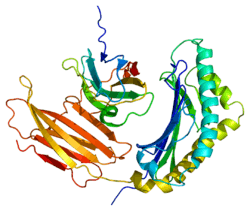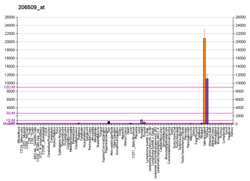Prolactin-induced protein
Prolactin-inducible protein also known as gross cystic disease fluid protein 15 (GCDFP-15), extra-parotid glycoprotein (EP-GP), gp17 seminal actin-binding protein (SABP) or BRST2 is a protein that in humans is encoded by the PIP gene.[5][6][7] It is upregulated by prolactin and androgens and downregulated by estrogen.
Function
The protein has a physiological function in regulation of water transport mainly in apocrine glands in the axilla, vulva, eyelid and ear canal, serous cells of the submandibular salivary gland, serous cells of the submucosal glands of the bronchi, and accessory lacrimal glands as well as cutaneous eccrine glands.[8] It is also found in amniotic fluid and seminal fluid.
PIP has the ability to bind immunoglobulin G (IgG), IgG-Fc, CD4-T cell receptor suggesting a wide range of immunological functions.[9][10] PIP also binds to AZGP1.[10] PIP exerts aspartyl proteinase activity able to cleave fibronectin.[11][12]
PIP can bind different species of bacteria showing highest affinity to sterptococci thus playing a role in non-immune defense of the body against pathogenic bacterial strains.[13][14]
Mitogenic effect of PIP was observed on both normal and malignant breast epithelial cells.[15]
Use as marker and significance in disease
Prolactin induced protein (called GCDFP-15 in this context) in breast cyst fluid or breast tissue serves as marker of both benign and malignant apocrine metaplasia as the protein is not normally expressed in breast tissue.[16][17] It is characteristic of low grade apocrine carcinoma of the breast, high grade apocrine carcinoma frequently loose expression of this marker.[18] PIP gene expression in breast cancer lines was associated with decreased cell proliferation and invasivenes and an increase of the apoptotic pathway. Many of the genes affected by PIP appear to be regulated by STAT5.[19]
A mitogenic effect of this protein on experimental breast cells lines MCF10A, MCF7, BT474, MDA-MB231 and T47D was detected.[15] Prolactin-induced protein has also been used for identification and detection of disseminated breast cancer cells.[20]
The PIP gene is amplified in some breast cancer lines accounting for some of its overexpression, however additional mechanisms are needed to completely explain its overexpression.[21] In T47D breast cancer cells, androgen receptor and RUNX2 interact to synergistically enhance PIP expression.[22]
In molecular apocrine breast cancer (ER-/AR+) there is a positive feedback loop between androgen receptor and extracellular signal-regulated kinase (ERK) via CREB1 which can be inhibited by anti-androgens. PIP expression is necessary for viability and invasiveness of this subtype of breast cancer.[23]
In ER+ breast cancer, particularly those with very high level of ER expression, PIP appears to play an important role in proliferation and invasion as well as acquired resistance to tamoxifen.[24]
References
- 1 2 3 GRCh38: Ensembl release 89: ENSG00000159763 - Ensembl, May 2017
- 1 2 3 GRCm38: Ensembl release 89: ENSMUSG00000058499 - Ensembl, May 2017
- ↑ "Human PubMed Reference:".
- ↑ "Mouse PubMed Reference:".
- ↑ Myal Y, Gregory C, Wang H, Hamerton JL, Shiu RP (July 1989). "The gene for prolactin-inducible protein (PIP), uniquely expressed in exocrine organs, maps to chromosome 7". Somat Cell Mol Genet. 15 (3): 265–70. PMID 2727805. doi:10.1007/BF01534877.
- ↑ Myal Y, Robinson DB, Iwasiow B, Tsuyuki D, Wong P, Shiu RP (January 1992). "The prolactin-inducible protein (PIP/GCDFP-15) gene: cloning, structure and regulation". Mol Cell Endocrinol. 80 (1–3): 165–75. PMID 1955075. doi:10.1016/0303-7207(91)90153-J.
- ↑ "Entrez Gene: PIP prolactin-induced protein".
- ↑ Mazoujian G, Pinkus GS, Davis S, Haagensen DE (February 1983). "Immunohistochemistry of a gross cystic disease fluid protein (GCDFP-15) of the breast. A marker of apocrine epithelium and breast carcinomas with apocrine features". Am. J. Pathol. 110 (2): 105–12. PMC 1916150
 . PMID 6130702.
. PMID 6130702. - ↑ Chiu WW, Chamley LW (December 2003). "Human seminal plasma prolactin-inducible protein is an immunoglobulin G-binding protein". J. Reprod. Immunol. 60 (2): 97–111. PMID 14638438. doi:10.1016/S0165-0378(03)00084-6.
- 1 2 Hassan MI, Waheed A, Yadav S, Singh TP, Ahmad F (February 2009). "Prolactin inducible protein in cancer, fertility and immunoregulation: structure, function and its clinical implications". Cell. Mol. Life Sci. 66 (3): 447–59. PMID 18854942. doi:10.1007/s00018-008-8463-x.
- ↑ Caputo E, Camarca A, Moharram R, Tornatore P, Thatcher B, Guardiola J, Martin BM (May 2003). "Structural study of GCDFP-15/gp17 in disease versus physiological conditions using a proteomic approach". Biochemistry. 42 (20): 6169–78. PMID 12755619. doi:10.1021/bi034038a.
- ↑ Caputo E, Manco G, Mandrich L, Guardiola J (March 2000). "A novel aspartyl proteinase from apocrine epithelia and breast tumors". J. Biol. Chem. 275 (11): 7935–41. PMID 10713110. doi:10.1074/jbc.275.11.7935.
- ↑ Lee B, Bowden GH, Myal Y (April 2002). "Identification of mouse submaxillary gland protein in mouse saliva and its binding to mouse oral bacteria". Arch. Oral Biol. 47 (4): 327–32. PMID 11922875. doi:10.1016/S0003-9969(01)00113-3.
- ↑ Schenkels LC, Walgreen-Weterings E, Oomen LC, Bolscher JG, Veerman EC, Nieuw Amerongen AV (February 1997). "In vivo binding of the salivary glycoprotein EP-GP (identical to GCDFP-15) to oral and non-oral bacteria detection and identification of EP-GP binding species". Biol. Chem. 378 (2): 83–8. PMID 9088536. doi:10.1515/bchm.1997.378.2.83.
- 1 2 Cassoni P, Sapino A, Haagensen DE, Naldoni C, Bussolati G (January 1995). "Mitogenic effect of the 15-kDa gross cystic disease fluid protein (GCDFP-15) on breast-cancer cell lines and on immortal mammary cells". Int. J. Cancer. 60 (2): 216–20. PMID 7829219. doi:10.1002/ijc.2910600215.
- ↑ Collette J, Hendrick JC, Jaspar JM, Franchimont P (July 1986). "Presence of alpha-lactalbumin, epidermal growth factor, epithelial membrane antigen, and gross cystic disease fluid protein (15,000 daltons) in breast cyst fluid". Cancer Res. 46 (7): 3728–33. PMID 3486713.
- ↑ Petrakis NL, Lowenstein JM, Wiencke JK, Lee MM, Wrensch MR, King EB, Hilton JF, Miike R (1993). "Gross cystic disease fluid protein in nipple aspirates of breast fluid of Asian and non-Asian women". Cancer Epidemiol. Biomarkers Prev. 2 (6): 573–9. PMID 8268776.
- ↑ Honma N, Takubo K, Arai T, Younes M, Kasumi F, Akiyama F, Sakamoto G (2006). "Comparative study of monoclonal antibody B72.3 and gross cystic disease fluid protein-15 as markers of apocrine carcinoma of the breast". APMIS. 114 (10): 712–9. PMID 17004974. doi:10.1111/j.1600-0463.2006.apm_434.x.
- ↑ Debily MA, Marhomy SE, Boulanger V, Eveno E, Mariage-Samson R, Camarca A, Auffray C, Piatier-Tonneau D, Imbeaud S (2009). "A functional and regulatory network associated with PIP expression in human breast cancer". PLoS ONE. 4 (3): e4696. PMC 2650800
 . PMID 19262752. doi:10.1371/journal.pone.0004696.
. PMID 19262752. doi:10.1371/journal.pone.0004696. - ↑ Lacroix M (December 2006). "Significance, detection and markers of disseminated breast cancer cells". Endocr. Relat. Cancer. 13 (4): 1033–67. PMID 17158753. doi:10.1677/ERC-06-0001.
- ↑ Ciullo M, Debily MA, Rozier L, Autiero M, Billault A, Mayau V, El Marhomy S, Guardiola J, Bernheim A, Coullin P, Piatier-Tonneau D, Debatisse M (November 2002). "Initiation of the breakage-fusion-bridge mechanism through common fragile site activation in human breast cancer cells: the model of PIP gene duplication from a break at FRA7I". Hum. Mol. Genet. 11 (23): 2887–94. PMID 12393800. doi:10.1093/hmg/11.23.2887.
- ↑ Baniwal SK, Little GH, Chimge NO, Frenkel B (May 2012). "Runx2 controls a feed-forward loop between androgen and prolactin-induced protein (PIP) in stimulating T47D cell proliferation". J. Cell. Physiol. 227 (5): 2276–82. PMID 21809344. doi:10.1002/jcp.22966.
- ↑ Naderi A, Meyer M (2012). "Prolactin-induced protein mediates cell invasion and regulates integrin signaling in estrogen receptor-negative breast cancer". Breast Cancer Res. 14 (4): R111. PMC 3680918
 . PMID 22817771. doi:10.1186/bcr3232.
. PMID 22817771. doi:10.1186/bcr3232. - ↑ Baniwal SK, Chimge NO, Jordan VC, Tripathy D, Frenkel B (2013). "Prolactin-induced protein (PIP) regulates proliferation of luminal A type breast cancer cells in an estrogen-independent manner". PLoS ONE. 8 (6): e62361. PMC 3670933
 . PMID 23755096. doi:10.1371/journal.pone.0062361.
. PMID 23755096. doi:10.1371/journal.pone.0062361.
Further reading
- Schaller J, Akiyama K, Kimura H, et al. (1991). "Primary structure of a new actin-binding protein from human seminal plasma". Eur. J. Biochem. 196 (3): 743–50. PMID 2013294. doi:10.1111/j.1432-1033.1991.tb15873.x.
- Murphy LC, Tsuyuki D, Myal Y, Shiu RP (1987). "Isolation and sequencing of a cDNA clone for a prolactin-inducible protein (PIP). Regulation of PIP gene expression in the human breast cancer cell line, T-47D". J. Biol. Chem. 262 (31): 15236–41. PMID 3667631.
- Touchman JW, Bouffard GG, Weintraub LA, et al. (1997). "2006 expressed-sequence tags derived from human chromosome 7-enriched cDNA libraries". Genome Res. 7 (3): 281–92. PMID 9074931. doi:10.1101/gr.7.3.281.
- Autiero M, Bouchier C, Basmaciogullari S, et al. (1997). "Isolation from a human seminal vesicle library of the cDNA for gp17, a CD4 binding factor". Immunogenetics. 46 (4): 345–8. PMID 9218538.
- Caputo E, Autiero M, Mani JC, et al. (1998). "Differential antibody reactivity and CD4 binding of the mammary tumor marker protein GCDFP-15 from breast cyst and its counterparts from exocrine epithelia". Int. J. Cancer. 78 (1): 76–85. PMID 9724097. doi:10.1002/(SICI)1097-0215(19980925)78:1<76::AID-IJC13>3.0.CO;2-3.
- Gaubin M, Autiero M, Basmaciogullari S, et al. (1999). "Potent inhibition of CD4/TCR-mediated T cell apoptosis by a CD4-binding glycoprotein secreted from breast tumor and seminal vesicle cells". J. Immunol. 162 (5): 2631–8. PMID 10072505.
- Caputo E, Manco G, Mandrich L, Guardiola J (2000). "A novel aspartyl proteinase from apocrine epithelia and breast tumors". J. Biol. Chem. 275 (11): 7935–41. PMID 10713110. doi:10.1074/jbc.275.11.7935.
- Basmaciogullari S, Autiero M, Culerrier R, et al. (2000). "Mapping the CD4 binding domain of gp17, a glycoprotein secreted from seminal vesicles and breast carcinomas". Biochemistry. 39 (18): 5332–40. PMID 10820003. doi:10.1021/bi992398l.
- Rieske P, Pongubala JM (2001). "AKT induces transcriptional activity of PU.1 through phosphorylation-mediated modifications within its transactivation domain". J. Biol. Chem. 276 (11): 8460–8. PMID 11133986. doi:10.1074/jbc.M007482200.
- Autiero M, Camarca A, Ciullo M, et al. (2002). "Intragenic amplification and formation of extrachromosomal small circular DNA molecules from the PIP gene on chromosome 7 in primary breast carcinomas". Int. J. Cancer. 99 (3): 370–7. PMID 11992405. doi:10.1002/ijc.10368.
- Strausberg RL, Feingold EA, Grouse LH, et al. (2003). "Generation and initial analysis of more than 15,000 full-length human and mouse cDNA sequences". Proc. Natl. Acad. Sci. U.S.A. 99 (26): 16899–903. PMC 139241
 . PMID 12477932. doi:10.1073/pnas.242603899.
. PMID 12477932. doi:10.1073/pnas.242603899. - Scherer SW, Cheung J, MacDonald JR, et al. (2003). "Human chromosome 7: DNA sequence and biology". Science. 300 (5620): 767–72. PMC 2882961
 . PMID 12690205. doi:10.1126/science.1083423.
. PMID 12690205. doi:10.1126/science.1083423. - Caputo E, Camarca A, Moharram R, et al. (2003). "Structural study of GCDFP-15/gp17 in disease versus physiological conditions using a proteomic approach". Biochemistry. 42 (20): 6169–78. PMID 12755619. doi:10.1021/bi034038a.
- Gerhard DS, Wagner L, Feingold EA, et al. (2004). "The status, quality, and expansion of the NIH full-length cDNA project: the Mammalian Gene Collection (MGC)". Genome Res. 14 (10B): 2121–7. PMC 528928
 . PMID 15489334. doi:10.1101/gr.2596504.
. PMID 15489334. doi:10.1101/gr.2596504. - Shishioh N, Hong Y, Ohishi K, et al. (2005). "GPI7 is the second partner of PIG-F and involved in modification of glycosylphosphatidylinositol". J. Biol. Chem. 280 (10): 9728–34. PMID 15632136. doi:10.1074/jbc.M413755200.
- Rual JF, Venkatesan K, Hao T, et al. (2005). "Towards a proteome-scale map of the human protein-protein interaction network". Nature. 437 (7062): 1173–8. PMID 16189514. doi:10.1038/nature04209.
- Ramachandran P, Boontheung P, Xie Y, et al. (2006). "Identification of N-linked glycoproteins in human saliva by glycoprotein capture and mass spectrometry". J. Proteome Res. 5 (6): 1493–503. PMID 16740002. doi:10.1021/pr050492k.
- Ewing RM, Chu P, Elisma F, et al. (2007). "Large-scale mapping of human protein-protein interactions by mass spectrometry". Mol. Syst. Biol. 3 (1): 89. PMC 1847948
 . PMID 17353931. doi:10.1038/msb4100134.
. PMID 17353931. doi:10.1038/msb4100134. - Lee B, Bowden GH, Myal Y (2002). "Identification of mouse submaxillary gland protein in mouse saliva and its binding to mouse oral bacteria". Arch Oral Biol. 47 (4): 327–32. PMID 11922875. doi:10.1016/S0003-9969(01)00113-3.
- Schenkels LC, Walgreen-Weterings E, Oomen LC, Bolscher JG, Veerman EC, Nieuw Amerongen AV (1997). "In vivo binding of the salivary glycoprotein EP-GP (identical to GCDFP-15) to oral and non-oral bacteria detection and identification of EP-GP binding species". Biol Chem. 378 (2): 83–8. PMID 9088536. doi:10.1515/bchm.1997.378.2.83.
External links
- BRST2 immunostaining - abcam.com.
- GCDFP-15 immunostaining - immunosaver.com.






